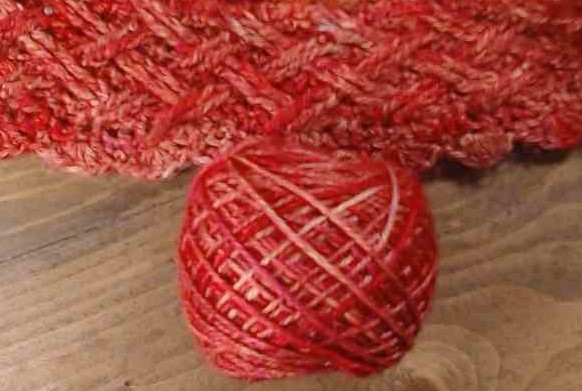Until fairly recently, if you wanted a variety of colors in a project, a basic crocheter was limited to two varieties of color changes variegated yarn or manual changes.
Variegated yarn has short color changes which generally repeat regularly and produces irregular color changes, sometimes pooling in one patch of your finished fabric. Pooling is a term used for the way variegated yarn can line up and with careful planning can be used to create beautiful plaid fabrics. This technique is called “planned pooling, and we will explore this in a later post.
This photo below shows a short color changing yarn in a ball and in the finished cabled fabric.

You can see the short stretches of light color in the ball and they show up as just lighter areas in the fabric. And the darker stretches do the same thing. You end up with a lightly mottled effect which is beautiful, especially when contrasted with solids or very similarly colored variegated yarns.
A longer color change produces a very different result. This yarn has long, almost striping length color changes. The changes are blended well, unlike some other striping yarns (which change abruptly, sometimes in the middle of a stitch!) but you get a fun contrast of many colors with just one ball.

This yarn is also presented in a really fun way so you see the clusters of color as they will stripe! It worked really well in this sweater below. This is not the identical colorway, but it’s the same yarn. The stripes are probably about 30 yards or maybe a little bit more. Enough that you can definitely make a pair of socks that stripe nicely, and probably some nice stripes on a sweather, but stripes would be very thin and may not extend the full width of larger projects, like a shawl or afghan.

Notice how the petals are striped and the ribbed area has a more ombre effect. Long, gradual color changes produce both of these variations with the stitchwork accenting them in different ways.
Recently, the hottest trend is extremely long, gradual color changes. These color changes happen over a 100 yard length or even more. These are generally four ply yarns (in several different weights) and the colors are changed very gradually, one ply at a time so it can be very hard to determine where the change happens once a project is finished.

This example has some pretty dramatic changes so you can get an idea of what that really looks like. Look at where the blue and lavender meet. There are some strands that almost appear candy striped. It does not look that dramatic in a finished project though.
This is an example of an ombre version of that yarn. It goes from black to white and then I bordered it with more black. You don’t really see where the change happens, but the overall effect is fabulous!

This is not the finished version of this shawl. I hope to have it released soon in it’s final version though!
So you can see, there are a number of variations on color changing yarn. I am not fond of the cakes of yarn that are sold with abrupt color changes. The aesthetic just doesn’t work for me. I find myself constantly staring at the one stitch where the change happened and it bugs me immensely. But, the colors and availability of that yarn are hard to resist! If you’re like me and that stitch will bother you, you can always cut the yarn at the end of a row when you think there isn’t enough of the same color to finish another row and start the new color early. It’s much easier on the eyes to have stripes start with a new row than interrupt another row.
Hope that’s helpful! Happy Hooking!
